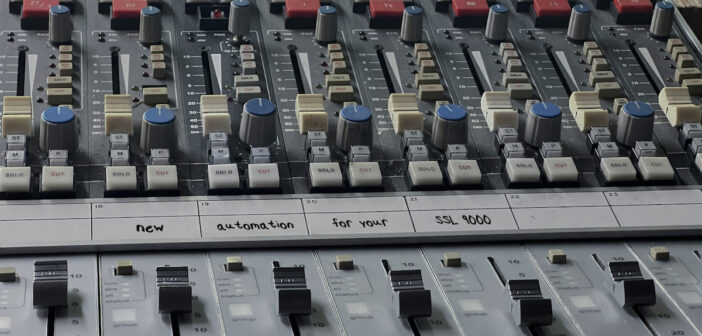In the field of audio mixing, precision and control are essential to produce high-quality sound. Among the many tools available on a mixing console, VCA (Voltage Controlled Amplifier) groups stand out for their ability to offer centralized and efficient control over the volume levels of multiple tracks. A VCA group allows you to manage several audio channels simultaneously while preserving the flexibility and independence of individual settings. This makes it a valuable asset for both studio engineers and those working live.
Using VCA groups can transform the way you approach mixing, offering greater fluidity and cohesion. They let you adjust the levels of multiple tracks with a single fader, maintain a clear and tidy overview of your session, and react quickly to the dynamic needs of live performance or studio recording.
The aim of this article is to provide an in-depth understanding of VCA groups and to show how to use them to optimize volume control on a mixing console. We will explore how they work, their benefits, and best practices to integrate them effectively into your mixing sessions, whether live or in the studio.
What Is a VCA Group?
Definition and Operation of VCA Groups
A VCA (Voltage Controlled Amplifier) group is a volume control mechanism used in advanced mixing consoles. Unlike traditional groups where audio signals are physically summed together, a VCA group controls the volume of multiple channels electronically without altering the audio signal path. In other words, the VCA acts like a remote control for the volume faders of the assigned channels, allowing simultaneous adjustment of several channels from a single control point.
The operation of VCA groups is based on the use of control voltages to regulate the gain of the associated channels. Each individual channel retains its original setting, but the VCA group allows proportional changes to the levels of all assigned channels. For example, if you lower the VCA fader by 5 dB, all channels under that group will see their volume reduced by 5 dB while maintaining their relative balance.
Differences Between VCA and Other Types of Groups
VCA groups differ from other types of groups such as mix groups and subgroups in several ways:
- Mix groups:
- In a traditional mix group, the audio signals of the assigned channels are summed together and treated as a single audio stream. Volume changes and applied effects affect the entire group collectively.
- Mix groups are useful for applying global processing, such as compression or EQ, to several tracks at once.
- Unlike VCA groups, mix groups directly modify the audio signal of the assigned channels.
- Subgroups:
- Subgroups are intermediate signal paths where multiple channels can be routed before reaching the main output. They allow you to manage and process a set of channels as a block.
- A subgroup can include global effects and volume adjustments that apply to all channels routed to that subgroup.
- Like mix groups, subgroups directly modify the audio signal, but they are often used for more complex mixing setups.
- VCA groups (Voltage Controlled Amplifiers):
- VCAs offer centralized volume control without altering the audio signal path. This means the sonic characteristics of the channels remain intact.
- VCAs allow you to manage the level of multiple channels without summing them together, thus preserving the individuality of each track while offering overall proportional control.
- VCA groups are particularly useful for dynamic and precise volume adjustments in both live and studio contexts, without compromising mixing flexibility.
VCAs provide a flexible, non-destructive control solution that complements traditional mix groups and subgroups. They offer an efficient way to manage the volume levels of several tracks simultaneously without compromising the quality and individuality of audio signals.
Benefits of VCA Groups
Centralized control of multiple track volumes
One of the main advantages of VCA groups is their ability to offer centralized control of the volume of multiple tracks simultaneously. By assigning several channels to a single VCA group, you can adjust the levels of these channels with a single fader move. This greatly simplifies volume management, especially in complex sessions with numerous channels. For example, in a live concert, you can quickly adjust the level of backing vocals using a single VCA fader rather than manipulating each individual fader. This centralization allows you to respond quickly to the dynamic needs of the performance, thereby improving mixing fluidity.
Preservation of individual settings
Another crucial advantage of VCA groups is that they allow the independence of each channel’s individual settings to be maintained. Unlike traditional mix groups that sum audio signals together, VCAs control volume levels proportionally without altering the audio signal path. This means each channel retains its unique gain, EQ, compression, and effects settings. As a result, adjustments made via the VCA fader only affect the overall volume of the assigned channels and do not interfere with the specific parameters of each track. This independence is particularly valuable when mixing complex pieces where each sound element requires fine adjustments to fit perfectly into the overall mix.
Improved flexibility and mixing efficiency
VCA groups significantly enhance mixing flexibility and efficiency. They allow sound engineers to make global adjustments without sacrificing granular control. For example, you can create VCA groups for different sections of your mix, such as percussion, strings, or backing vocals, and quickly adjust those sections’ levels based on performance dynamics or the mix’s specific needs.
In addition, VCAs make it easier to manage complex scenes by enabling smooth and precise transitions between different mixing configurations. During a live show, VCA groups facilitate quick and coordinated adjustments, which are essential for maintaining consistent, professional sound quality.
Configuring VCA Groups on a Mixing Console
Steps to assign tracks to a VCA group
Setting up VCA groups on a mixing console is a relatively simple process but requires a clear understanding of the steps involved. Here’s how to proceed:
- Select the channels to assign:
- Identify the tracks you want to control together via a VCA group. This could be a set of similar instruments (for example, all drum tracks) or a combination of vocals and instruments requiring simultaneous adjustment.
- Create a VCA group:
- On the mixing console, go to the VCA group configuration section. This may vary depending on the console, but it is generally a menu or a set of buttons dedicated to VCAs.
- Assign the tracks to the VCA group:
- Select the individual tracks and assign them to the desired VCA group. On many consoles, this is done by pressing a group button on each channel or by using a software interface to assign the channels.
- Label the VCA group:
- For better organization, label your VCA group appropriately. For example, “Drums VCA” or “Vocals VCA.” This makes identification and quick adjustments easier during mixing sessions.
Fader and level configuration
Once the tracks are assigned to the VCA group, it is crucial to properly configure the faders and levels for optimal control:
- Set individual levels:
- Before using the VCA fader, make sure the individual levels of each track are properly set. Each track should be balanced relative to the others in the context of the overall mix.
- Use the VCA fader for global adjustments:
- Use the VCA fader to perform global volume adjustments. For example, by lowering the VCA fader, all assigned tracks will have their volume reduced proportionally without altering their internal balance.
- Monitor changes:
- Keep an eye on the level indicators for each track and for the VCA group. This ensures levels remain appropriate and that no track is overloaded or too weak.
Practical example of assignment and control
To illustrate, here is a practical example of using a VCA group in a mixing situation:
- Mixing scenario:
- You are mixing a live performance including drums, bass, multiple guitars, keyboards, and vocals.
- Creating VCA groups:
- You decide to create one VCA group for drums, another for guitars, and a third for vocals.
- Assigning tracks:
- For the “Drums VCA” group, assign all drum tracks (kick, snare, toms, hi-hat, overheads) to this group.
- For the “Guitars VCA” group, assign all guitar tracks (rhythm guitar, lead guitar).
- For the “Vocals VCA” group, assign all vocal tracks (lead vocal, backing vocals).
- Global adjustments:
- During the concert, use the “Drums VCA” group fader to adjust the overall drum volume depending on performance dynamics.
- Likewise, adjust the “Guitars VCA” and “Vocals VCA” group faders to maintain a consistent balance in the mix.
By using VCA groups, you can effectively control the volume levels of multiple tracks, improve the fluidity of your mixing, and respond quickly to the dynamic needs of live performance or studio work.
Practical Applications of VCA Groups
Use in live mixes
VCA groups are particularly advantageous in live mixing situations, where quick and precise adjustments are essential. Here’s how they can be used effectively:
- Centralized control of instrument sections:
- By assigning instrument groups (for example, all drum tracks, all guitars, or all vocals) to VCAs, you can quickly and simultaneously adjust the volume of these groups without affecting the internal balance of individual tracks.
- Real-time dynamic adjustments:
- During a concert, sound levels can fluctuate considerably. VCA groups allow you to respond to these dynamic changes by quickly adjusting the volume of entire sections, ensuring that each element of the mix remains well-balanced and clear.
- Ease of management:
- In a live sound environment, the console can be crowded with many channels. VCA groups simplify this complexity by reducing the number of faders the engineer must actively manage, allowing greater focus on creative adjustments and the immediate needs of the performance.
Managing large studio recording sessions
In the studio, VCA groups bring increased flexibility and precision, particularly useful in large recording sessions:
- Simplified control of large setups:
- In sessions with dozens or even hundreds of tracks, VCA groups allow you to control the levels of entire sections (such as strings, brass, or choirs) with a single fader, making overall mix management much smoother.
- Progressive, non-destructive mixing:
- Adjustments via VCAs do not affect individual track settings, enabling you to refine overall levels without having to readjust each track individually. This is particularly useful for fine-tuning balances during the final mix or for making quick revisions based on client feedback.
- Precise automation:
- Digital consoles and DAWs allow VCA automation. This means engineers can program complex volume adjustments that apply to multiple tracks simultaneously, adding an extra dimension of control to the session.
Concrete examples for different types of music
VCA groups can be adapted to various musical genres, each with specific mixing requirements:
- Rock music:
- In a rock mix, a VCA group can be used to control all guitars, enabling quick volume adjustments of rhythm and lead guitars to ensure they remain powerful yet balanced against vocals and drums.
- Classical music:
- For an orchestra, VCAs can control the strings, woodwinds, brass, and percussion sections. This allows precise adjustments of the different orchestral sections, maintaining perfect balance and ensuring each section blends harmoniously with the others.
- Electronic music:
- In electronic music, where numerous synthesizer, electronic percussion, and effects tracks may be present, VCA groups make it easier to control layers of synths or different percussion sections, enabling smooth transitions and effortless dynamic variations.
- Pop music:
- For a pop mix, VCA groups can bundle lead and backing vocals, rhythm elements, or synths and effects, allowing you to manage each group’s volume coherently and evenly according to the production’s requirements.
Comparison with other volume control techniques
Comparison with traditional mix groups
VCA groups and traditional mix groups offer two distinct approaches to controlling the volume of multiple tracks. Here is a detailed comparison:
VCA groups:
- Volume control: VCA groups allow you to control the volume of multiple tracks without affecting the audio signal path. The volume adjustment is done proportionally for each assigned track.
- Flexibility: Individual settings for each track (such as EQ, effects, and dynamics) remain independent. Changes via the VCA do not alter these parameters.
- Use: Ideal for quick and precise adjustments in live or studio contexts, particularly useful for maintaining balance while adjusting overall volume.
Traditional mix groups:
- Volume control: The audio signals of the assigned tracks are summed together, and volume control applies to the combined signal. Processing (such as compression or EQ) can also be applied globally to this combined signal.
- Flexibility: Less flexible than VCAs because any change affects the global signal. However, it allows global processing that can be advantageous in some contexts.
- Use: Useful for applying collective processing to a set of tracks (such as a drum section or a vocal group), offering a simple solution for group processing.
Advantages and disadvantages compared to subgroups
Subgroups, like traditional mix groups, offer a different approach to volume control compared to VCA groups. Here is a comparison:
Subgroups:
- Volume control: Similar to mix groups, the signals from the assigned tracks are routed to a subgroup, where the volume can be controlled collectively. Effects and processing can also be applied to the subgroup.
- Global processing: Allows global processing, which is useful for standardizing the sound of multiple tracks. For example, applying uniform compression to all drum tracks.
- Flexibility: Less flexible than VCAs in terms of preserving individual settings. Any volume or processing change affects the entire group.
- Use: Ideal for collective processing where sound uniformity is desired, such as homogeneous instrument sections (strings, brass) or vocal harmonies.
VCA groups:
- Volume control: Provides proportional volume control without modifying the individual audio signal path.
- Independence: Individual processing and settings remain intact, offering great flexibility in mixing.
- Use: Particularly useful in situations where flexibility and track independence are essential, such as in complex live sound configurations or multi-track recording sessions.
Specific use cases for each technique
VCA groups:
- Live sound: During concerts or live performances, VCAs allow quick and precise volume adjustments of entire sections of instruments or vocals without disturbing the internal balance.
- Large studio sessions: In the studio, VCAs simplify the management of sessions with many tracks, enabling overall adjustments while preserving the detailed settings of each track.
Traditional mix groups:
- Global processing: Used to apply collective processing (such as compression, EQ, or reverb) to several tracks simultaneously, offering uniform treatment.
- Homogeneous sections: Ideal for homogeneous instrument sections where uniform processing is desired, such as a brass or string section.
Subgroups:
- Intermediate mixing: Useful for grouping several tracks before sending them to the main output, allowing intermediate control of levels and processing.
- Specific processing: Apply specific effects or processing to a group of tracks before integrating them into the main mix, such as adding collective reverb to a choir section.

Tips to optimize the use of VCA groups
Advice for effective level management
- Define clear groups:
- Before starting to mix, identify the instrument or vocal sections that will benefit most from centralized control. For example, create groups for percussion, guitars, lead vocals, and backing vocals.
- Adjust individual levels first:
- Make sure the individual levels of each track are well balanced before assigning them to a VCA group. This ensures that global adjustments made via the VCA will maintain a coherent mix.
- Use clear labels:
- Name your VCA groups descriptively to facilitate quick identification. Use names like “Drums VCA,” “Guitars VCA,” or “Vocals VCA” to avoid confusion during mixing.
- Proportional changes:
- Remember that adjustments made on a VCA group affect all assigned channels proportionally. This is particularly useful for maintaining the relative balance of volume levels when making global changes.
Best practices for organizing tracks and groups
- Logical structure:
- Organize your tracks logically on the console. Place tracks assigned to the same VCA group close to each other for easier visualization and manipulation.
- Use colors:
- If your console or DAW allows, use color codes to differentiate VCA groups. For example, assign a specific color to all drum tracks and their corresponding VCA.
- Judicious grouping:
- Avoid overloading a VCA group with too many tracks. Limit each VCA to coherent sections of instruments or vocals to maintain precise and effective control.
- Review and readjust:
- Regularly review the organization of your VCA groups based on the needs of the mix. Don’t hesitate to reassign or create new groups if necessary to adapt to the project’s requirements.
Avoiding common errors and pitfalls
- Overusing VCAs:
- Although VCAs are powerful, avoid overusing them. Too many VCA groups can complicate mixing and make overall control less intuitive.
- Forgetting individual levels:
- Do not rely solely on VCAs for level control. Individual track settings remain crucial to a balanced mix. Make sure to adjust them properly before assigning them to a VCA group.
- Poor configuration of sends and returns:
- Pay attention to the sends and returns associated with your tracks. Volume changes via VCAs do not affect send levels, which can lead to imbalances if the sends are not adjusted accordingly.
- Confusion with other groups:
- Do not confuse VCA groups with subgroups or mix groups. Make sure you understand their roles and use them appropriately to avoid unwanted signal processing.
- Lack of audio verification:
- Listen carefully to changes made via VCAs. Sometimes adjustments can have unexpected effects on the overall mix. Use your ears to validate each change and ensure it contributes positively to the overall mix.
By applying these tips, you will be able to optimize the use of VCA groups, thereby improving level management and the overall quality of your mixes. A structured approach and mindful organization of tracks and VCA groups will help you get the most out of this powerful tool, both in the studio and in live sound environments.
Mastering VCA groups is essential for any sound engineer aiming to reach a professional level of mixing. Their ability to centralize control while preserving the independence of individual track settings makes them an indispensable tool for balanced and dynamic mixes.
We strongly encourage you to experiment with VCA groups in your own mixing sessions. By integrating these techniques, you can significantly improve your efficiency and the quality of your audio productions, whether live or in the studio. Take advantage of this powerful technology to refine your craft and reach new heights in your mixing projects.
Additional resources
Links to video tutorials and in-depth guides
- How to use VCA groups – Sound on Sound
- Differences between VCAs and subgroups – iZotope
- Tutorial on creating VCA groups on Avid S6 – Production Expert
- Online course on mix groups and VCA faders – macProVideo
- Setting up VCA groups in Studio One 5 – Ask.Video
- Introduction to dimensional mixing – Dance Music Production
- Audio routing explained – The REAPER Blog
- Tutorial on automating VCA masters in Pro Tools – Production Expert
- The differences between mix groups and VCA faders – macProVideo
- Understanding VCA groups and their usefulness – Sweetwater
Suggested further reading on mixing techniques
- The Mixing Engineer’s Handbook by Bobby Owsinski
- Mixing Secrets for the Small Studio by Mike Senior
- Zen and the Art of Mixing by Mixerman
- Audio Mixing Boot Camp by Bobby Owsinski
- The Art of Mixing: A Visual Guide to Recording, Engineering, and Production by David Gibson
- Audio Engineering 101: A Beginner’s Guide to Music Production by Tim Dittmar
- The Mastering Engineer’s Handbook by Bobby Owsinski
- Sound and Recording: Applications and Theory by Francis Rumsey and Tim McCormick
- Modern Recording Techniques by David Miles Huber and Robert E. Runstein
Recommended tools and software for advanced VCA management
- Pro Tools – One of the most popular DAWs for advanced VCA management and professional mixes.
- Studio One – Offers advanced mixing features and VCA management.
- Logic Pro X – Another robust DAW with excellent VCA group management.
- Cubase – Offers extensive routing capabilities and VCA group management.
- Ableton Live – Although more performance-oriented, it provides powerful tools for VCA group management.
- Reaper – Known for its flexibility and advanced routing capabilities.
- Harrison Mixbus – Provides an analog-style approach with advanced VCA group management features.
- Reason – Integrated with effective mixing and VCA group management tools.
- FL Studio – Known for its ease of use and VCA management capabilities.
- Nuendo – A professional DAW for audio post-production and advanced VCA management.




